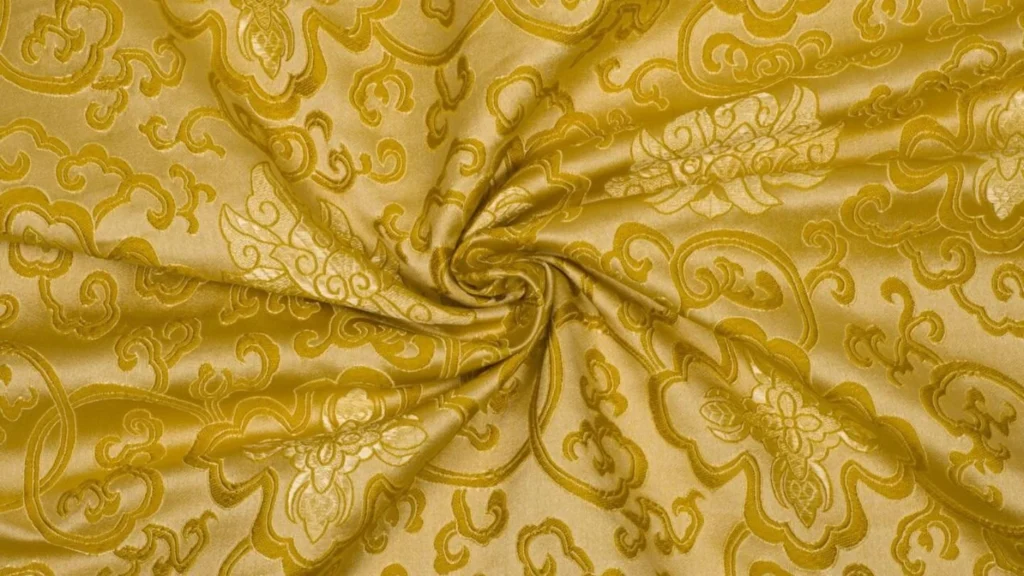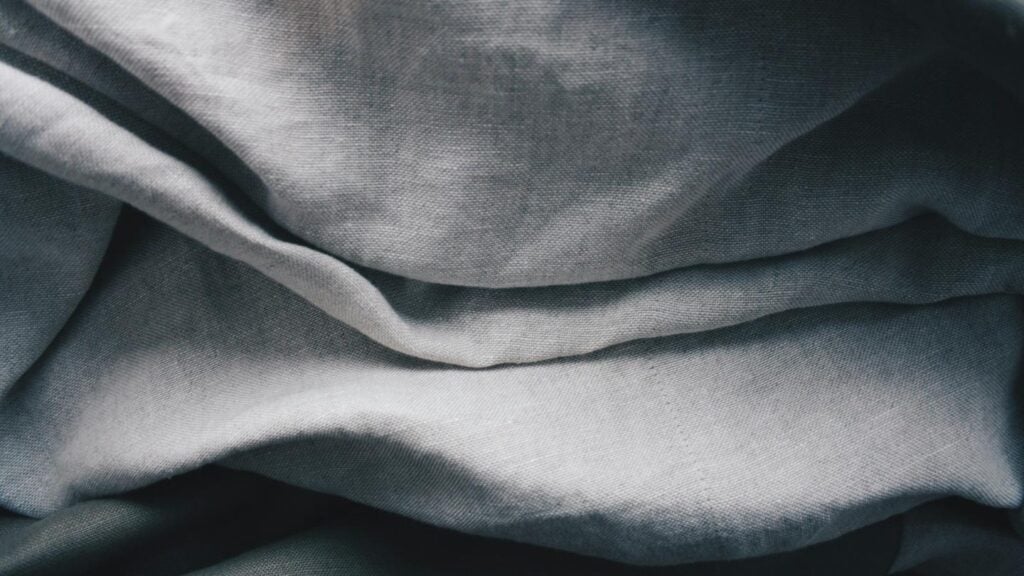2 – Shantung Fabric Composition
3 – Shantung Fabric vs Other Fabrics
4 – Shantung Fabric Is Manufactured
5 – Common Uses in Fashion
6 – Understanding the Environmental Impact of Shantung Fabric
7 – Exploring Price Points and Value for Money
8 – Conclusion
9 – FAQs
What is Shantung Fabric?
Shantung fabric is a luxurious textile known for its distinct texture and elegant appearance. Originally made from silk, it is highly prized for its smooth yet slightly textured finish, which comes from the unique way it is woven. Named after the Shandong province in China, where it was first produced, shantung has become a popular choice in fashion, particularly for formal wear, evening gowns, and bridal dresses. Here’s a closer look at what makes shantung fabric so special:
- Distinct Texture: Shantung has a smooth surface with a slight irregularity, giving it a rich texture. The fabric’s unique finish is the result of a weaving technique that includes both thick and thin threads, which creates a subtle, lustrous sheen.
- Material Composition: Traditionally made from silk, shantung fabric can also be produced using synthetic fibers like polyester or nylon. While silk shantung offers a more refined finish, synthetic versions are more affordable and easier to care for, making the fabric more accessible.
- Lightweight yet Structured: One of shantung’s key qualities is its balance between lightness and structure. It holds its shape well without being too heavy, making it an ideal choice for creating voluminous skirts, formal gowns, and elegant suits.
- Durability and Elegance: The fabric is prized not only for its appearance but also for its durability, especially in its silk form. It offers a high level of resilience, making it suitable for garments that require both style and function.
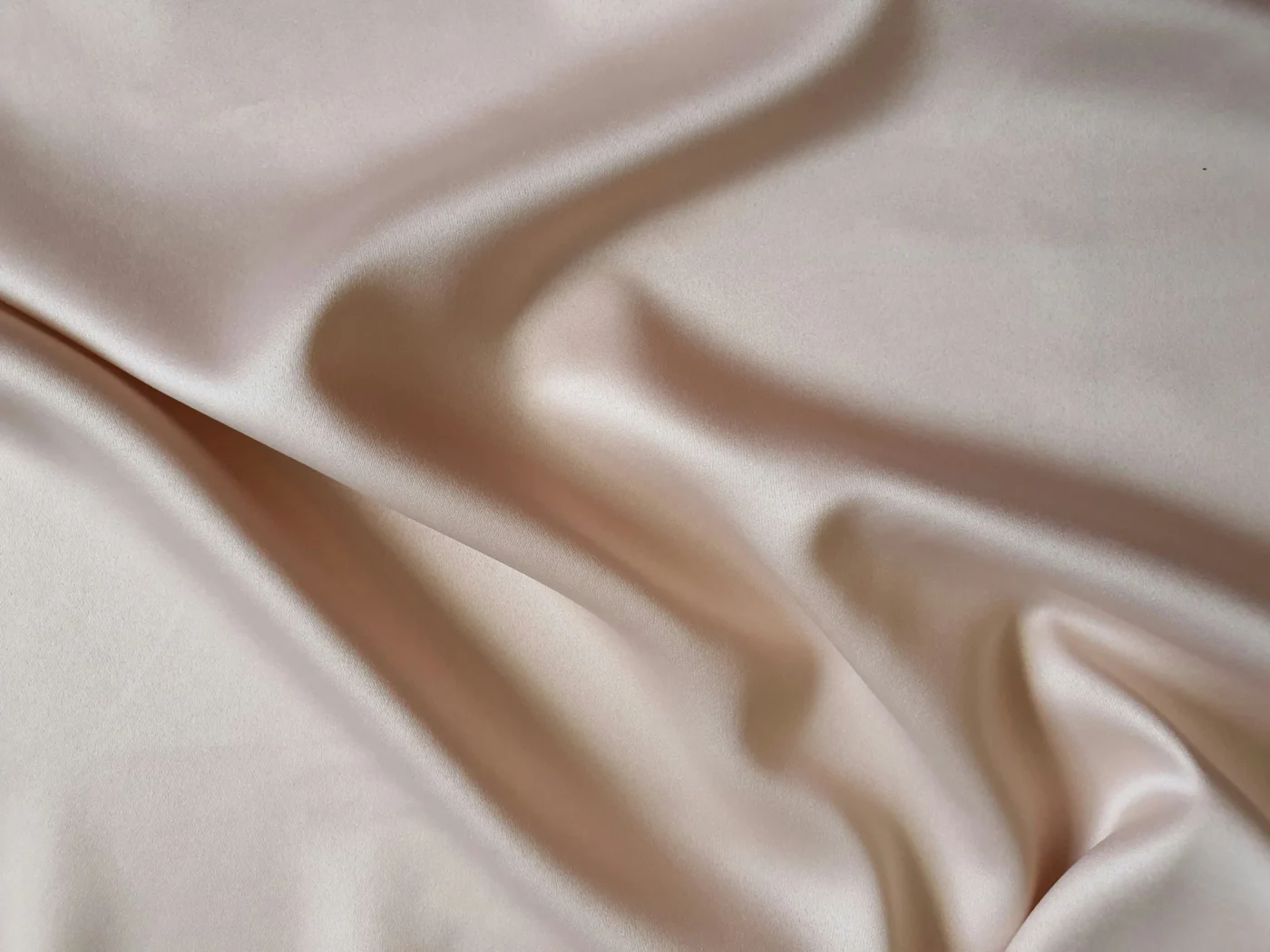
Shantung fabric’s elegant texture, versatile composition, and ability to hold its shape make it a staple in high-end fashion, perfect for those seeking a refined yet resilient material.
Shantung Fabric Composition
Shantung fabric is traditionally made from silk, but it can also be produced from synthetic fibers and blends, offering various textures and price points.
- Silk Shantung: The luxurious version, known for its smooth texture and subtle sheen, used in high-end fashion like evening wear and bridal gowns.
- Synthetic Shantung: Made from polyester or nylon, synthetic shantung is more affordable, durable, and easier to care for, but lacks the natural softness and sheen of silk.
- Blended Shantung: A mix of silk and synthetic fibers, offering a balance of luxury and affordability, with some sheen and durability.
- Weight and Finish: The fabric’s weight varies, with silk shantung being lighter and more fluid, while synthetic versions tend to be heavier and more wrinkle-resistant.
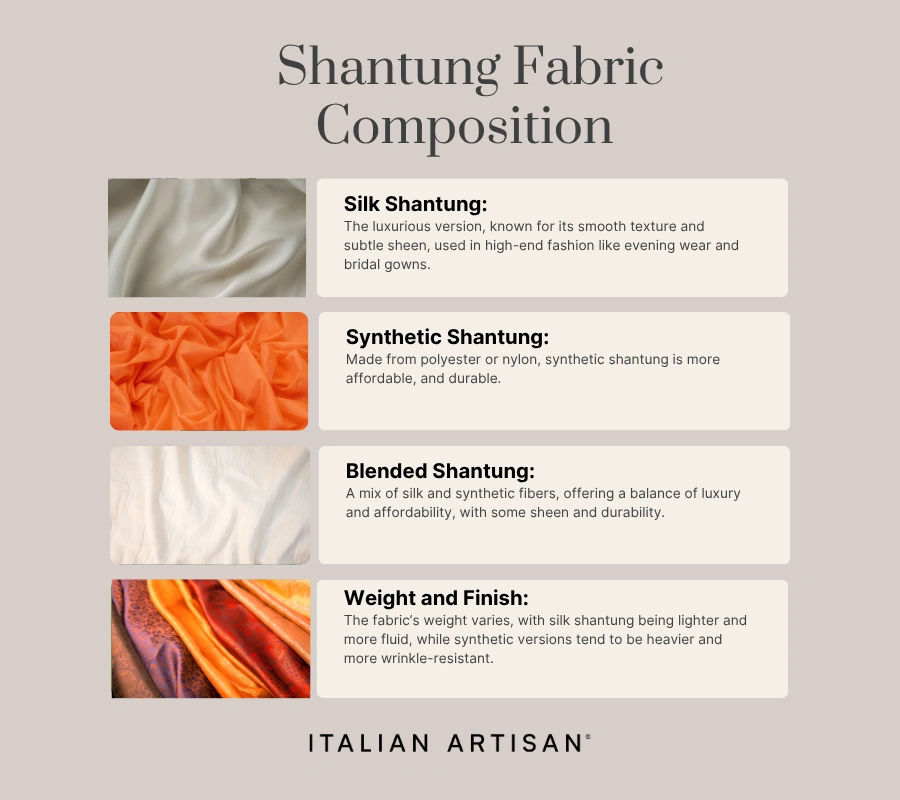
The composition of shantung fabric affects its appearance, feel, and price, helping you choose the best option based on your needs.
Shantung Fabric vs Other Fabrics
Shantung fabric shares some similarities with other luxurious textiles but stands out due to its unique texture and structure. Here’s how it compares to other common fabrics:
- Shantung vs Silk Taffeta: Both fabrics are crisp and hold their shape well, but taffeta is smoother and shinier, while shantung has a more textured, slubby finish. Taffeta is often used for more structured gowns, while shantung offers a softer, more elegant drape.
- Shantung vs Dupioni Silk: Dupioni silk is similar to shantung in its texture but is heavier and has a more pronounced unevenness in the threads. Shantung is lighter and smoother, making it ideal for less structured garments like blouses and dresses, whereas dupioni is often used for more formal attire and home furnishings.
- Shantung vs Organza: Organza is a sheer, crisp fabric often used for overlays or evening wear, while shantung is more substantial and opaque. Organza is lighter and more delicate, whereas shantung provides more structure and durability.
- Shantung vs Cotton: Shantung has a more luxurious, silky texture, while cotton is softer and more breathable. Cotton is more casual and comfortable for everyday wear, whereas shantung is typically used for more formal occasions.
Each fabric has its unique characteristics, but shantung’s balanced texture and structured yet fluid drape make it ideal for elegant formal wear, evening gowns, and other high-fashion garments.
How Shantung Fabric Is Manufactured
Shantung fabric is known for its unique texture, which is achieved through a specific weaving and finishing process. Here’s a breakdown of how shantung is typically made:
- Weaving: Shantung fabric is woven with a technique that includes both thick and thin threads, creating a slightly irregular texture. This gives the fabric its characteristic slubby finish, with visible variations in the thread thickness that add depth and richness.
- Silk Production: Traditionally, shantung is made from silk, which is harvested from silkworms. The silk threads are carefully spun into fine yarns, which are then woven into the fabric. Silk shantung has a luxurious sheen and smoothness, though the texture remains slightly rough due to the irregular weaving process.
- Synthetic Versions: Modern shantung can also be made from synthetic fibers like polyester or nylon. These fibers are spun into threads and woven similarly to silk, but they tend to be more durable and affordable. Synthetic shantung typically has a less pronounced texture but still retains some of the fabric’s signature crispness.
- Finishing Process: After weaving, the fabric may undergo finishing treatments, such as steaming, pressing, or dyeing, to enhance its texture, color, and overall quality. In the case of silk shantung, the fabric may be treated to improve its luster and smoothness.

The manufacturing process of shantung fabric, particularly its weaving technique, is what gives it its distinctive texture, making it a popular choice for luxury fashion items.
Produce your fashion collection with us
Common Uses in Fashion
Shantung fabric is prized for its elegance and versatility, making it a popular choice in a variety of fashion applications. Its crisp texture and subtle sheen make it ideal for both formal and high-fashion garments.
- Evening Wear: Shantung is commonly used in evening gowns, cocktail dresses, and other formal attire due to its ability to hold shape and its refined finish. Its luxurious texture adds sophistication to any special occasion outfit.
- Bridal Fashion: Shantung is often used for wedding dresses and bridesmaid gowns. The fabric’s structure allows for voluminous skirts and delicate detailing, making it perfect for creating stunning bridal silhouettes.
- Suits and Jackets: Shantung fabric’s crispness and durability make it a good choice for formal suits, especially for women. It can be used to create sharp, structured jackets or skirts that still have a touch of elegance.
- Cocktail Dresses and Formal Skirts: Shantung’s ability to maintain structure without being too heavy makes it an excellent option for cocktail dresses and structured skirts, giving a polished and sophisticated look.
- Accessories: Beyond clothing, shantung is also used for accessories such as handbags, neckties, and sashes. The fabric’s sheen adds a luxurious touch to these items.

Shantung fabric’s versatility allows it to be used in a wide range of fashion items, from high-end evening wear to elegant accessories, making it a go-to material for special occasions.
Understanding the Environmental Impact of Shantung Fabric
The environmental impact of shantung depends on whether it’s made from silk or synthetic fibers:
- Silk Production: Silk shantung is biodegradable, but the production of silk involves large water usage and can contribute to deforestation, impacting ecosystems.
- Synthetic Shantung: Made from polyester or nylon, synthetic shantung is less eco-friendly. These materials are non-biodegradable and contribute to pollution, particularly microplastics.
- Dyeing Process: Dyeing shantung, especially silk, can involve harmful chemicals and significant water usage. Eco-friendly dyeing methods can reduce this impact.
- Sustainable Alternatives: Organic silk and biodegradable synthetics provide more sustainable options for shantung fabric, reducing the environmental footprint.
- Durability: Shantung’s long-lasting nature reduces the need for frequent replacements, which can help minimize waste.
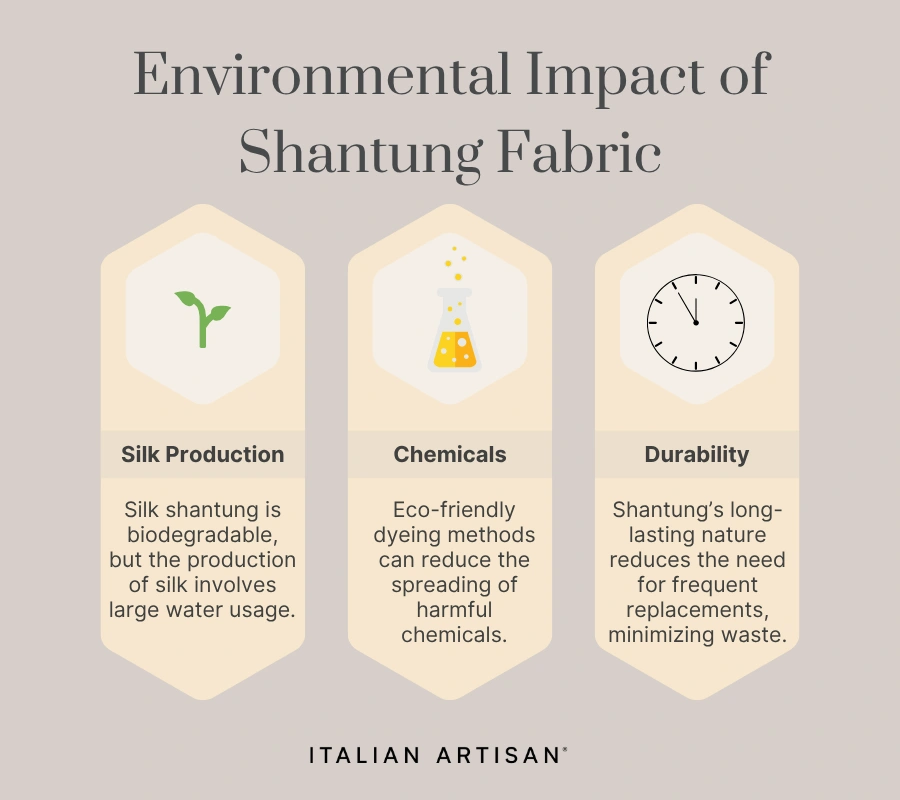
Choosing sustainable silk or synthetic alternatives can make shantung a more eco-conscious option.
Exploring Price Points and Value for Money
Shantung fabric comes in a range of prices, depending on its composition and quality. Here’s how its cost is influenced:
- Silk Shantung: The most luxurious and expensive version of shantung, silk shantung offers a smooth, elegant finish. It’s typically used for high-end fashion like bridal wear and evening gowns, justifying its higher price due to the quality of the raw material and the intricate production process.
- Synthetic Shantung: Shantung made from synthetic fibers like polyester or nylon is more affordable. While it mimics the look of silk, it lacks the natural sheen and feel but offers greater durability and easier maintenance at a lower price point.
- Blended Fabrics: Some shantung fabrics are made from blends of silk and synthetic fibers. These fabrics offer a balance of luxury and affordability, providing a similar aesthetic to silk but at a more budget-friendly price.
- Durability vs Cost: Although silk shantung is more expensive, its durability and timeless appeal can make it a worthwhile investment for high-quality garments that last. Synthetic versions may be cheaper but are still durable and ideal for everyday use.

Shantung fabric offers a variety of options for different budgets, from luxurious silk to affordable synthetics, making it a versatile choice for both high-end and more practical applications.
Conclusion
Shantung fabric is a luxurious and versatile textile, prized for its crisp texture and elegant appearance. Whether made from silk or synthetic fibers, it remains a popular choice for evening wear, bridal fashion, and high-end garments.
- Key Features: Shantung offers a smooth, structured finish, making it ideal for formal and elegant clothing.
- Sustainability: Eco-friendly alternatives and its durability help reduce its environmental impact.
- Affordability: From high-end silk to affordable synthetics, shantung suits a range of budgets.
Overall, shantung fabric combines sophistication, durability, and versatility, making it a timeless fabric for various fashion applications.
FAQs
- What is shantung fabric made of?
Shantung is traditionally made from silk, but it can also be made from synthetic fibers like polyester or nylon for more affordable options. - Is shantung fabric expensive?
Silk shantung is more expensive due to its luxurious quality, while synthetic versions are more affordable but still provide a similar appearance. - How do you care for shantung fabric?
Silk shantung requires dry cleaning, while synthetic shantung can often be machine-washed. Always check care instructions for specific fabrics. - What is the difference between shantung and taffeta?
Both fabrics are crisp, but taffeta is smoother and shinier, while shantung has a more textured, slubby finish. - Can shantung be used for casual wear?
Shantung is primarily used for formal occasions, like evening gowns and bridal wear, due to its structured and elegant finish. - Is shantung fabric durable?
Yes, shantung is durable, especially in its synthetic forms. Silk shantung is also strong but requires more delicate care. - What makes shantung fabric unique?
Shantung’s unique texture comes from its irregular weaving, which creates subtle variations in thickness, giving it a slightly rough feel compared to smoother fabrics. - Can shantung be used for upholstery?
While shantung can be used for decorative pieces or lightweight upholstery, it is typically not durable enough for heavy-duty furniture use. - Is shantung fabric eco-friendly?
Silk shantung has a more natural, biodegradable composition, but its production can have environmental impacts. Sustainable alternatives and eco-friendly production methods are becoming more common. - How does shantung compare to dupioni silk?
Dupioni silk is heavier and more uneven in texture, while shantung is lighter, smoother, and typically used for more delicate, elegant garments.




